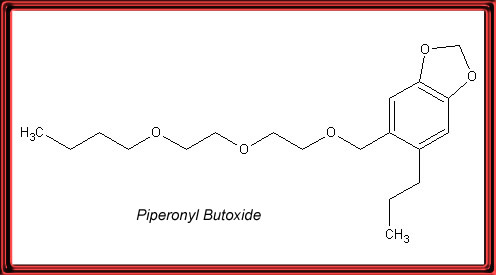Piperonyl Butoxide is a synergist used in a wide variety of insecticides and was developed in 1947 using naturally occurring safrole as the key raw ingredient. Synergists are chemicals which, whilst lacking pesticidal properties of their own, enhance the pesticidal properties of other active ingredients. Piperonyl Butoxide is used in conjunction with insecticides such as pyrethrins, pyrethroids, rotenone and carbamates.OK..! so how does it work...well it inhibits the detoxification of the pesticide by the insect. Some of an insect's metabolic enzymes, known as Cytochrome P450, can detoxify an active ingredient before the desired affect is achieved, and I am not going to go into the mechanism by which it achieves that here. Adding piperonyl butoxide reduces the amount of active ingredient required to achieve the affect we want and disrupts the enzyme activity, thus indirectly it sort of makes the insecticide a bit more environmentally friendly by reducing concentrations, something we all want.
The structure above may seem to be different in some drawings due to rotation
about the single bonds.Chemical Formula: C19H30O5
Other Names: 1,3-Benzodioxole, 5-[[2-(2-butoxyethoxy)ethoxy]methyl]-6-propyl-; Toluene, α-[2-(2-butoxyethoxy)ethoxy]-4,5-(methylenedioxy)-2-propyl-; Butacide; Butocide; Butyl carbitol 6-propylpiperonyl ether; ENT 14,250; Pyrenone 606; 6-Propylpiperonyl butyl diethylene glycol ether; α-(2-(2-n-Butoxyethoxy)-ethoxy)-4,5-methylenedioxy-2-propyltoluene; α(2-(2-Butoxyethoxy)ethoxy)-4,5-methylenedioxy-2-propyltoluene; (3,4-Methylenedioxy-6-propylbenzyl) (butyl) diethylene glicol ether; Butylcarbityl (6-propylpiperonyl) ether; Ethanol butoxide; FMC 5273; NCI-C02813; NIA 5273; PB; 3,4-Methylendioxy-6-propylbenzyl-n-butyl-diaethylenglykolaether; 3,4-Methylenedioxy-6-propylbenzyl n-butyl diethyleneglycol ether; 5-((2-(2-Butoxyethoxy)ethoxy)methyl)-6-propyl-1,3-benzodioxole; 5-Propyl-4-(2,5,8-trioxa-dodecyl)-1,3-benzodioxol; 6-(Propylpiperonyl)butylcarbityl ether; Butoxide; FAC 5273; Nusyn-noxfish; Prentox; Pybuthrin; Pyrenon; Synpren-fish.
LD50/LC50: The oral LD50 for rats is 6150 mg/kg and for mice it is 3800 mg/kg, thus indicating that in itself it is not too toxic, remember the bigger the number the less the toxicity.
